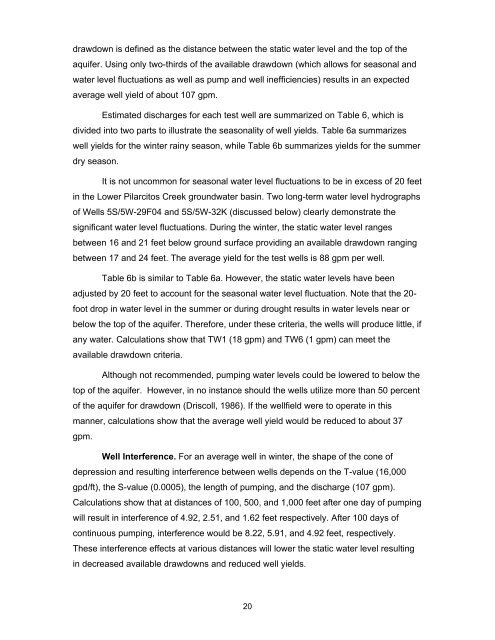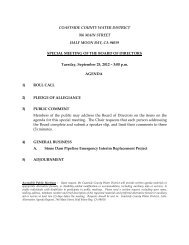Lower Pilarcitos Creek Groundwater Basin Study - Coastside ...
Lower Pilarcitos Creek Groundwater Basin Study - Coastside ...
Lower Pilarcitos Creek Groundwater Basin Study - Coastside ...
You also want an ePaper? Increase the reach of your titles
YUMPU automatically turns print PDFs into web optimized ePapers that Google loves.
drawdown is defined as the distance between the static water level and the top of the<br />
aquifer. Using only two-thirds of the available drawdown (which allows for seasonal and<br />
water level fluctuations as well as pump and well inefficiencies) results in an expected<br />
average well yield of about 107 gpm.<br />
Estimated discharges for each test well are summarized on Table 6, which is<br />
divided into two parts to illustrate the seasonality of well yields. Table 6a summarizes<br />
well yields for the winter rainy season, while Table 6b summarizes yields for the summer<br />
dry season.<br />
It is not uncommon for seasonal water level fluctuations to be in excess of 20 feet<br />
in the <strong>Lower</strong> <strong>Pilarcitos</strong> <strong>Creek</strong> groundwater basin. Two long-term water level hydrographs<br />
of Wells 5S/5W-29F04 and 5S/5W-32K (discussed below) clearly demonstrate the<br />
significant water level fluctuations. During the winter, the static water level ranges<br />
between 16 and 21 feet below ground surface providing an available drawdown ranging<br />
between 17 and 24 feet. The average yield for the test wells is 88 gpm per well.<br />
Table 6b is similar to Table 6a. However, the static water levels have been<br />
adjusted by 20 feet to account for the seasonal water level fluctuation. Note that the 20-<br />
foot drop in water level in the summer or during drought results in water levels near or<br />
below the top of the aquifer. Therefore, under these criteria, the wells will produce little, if<br />
any water. Calculations show that TW1 (18 gpm) and TW6 (1 gpm) can meet the<br />
available drawdown criteria.<br />
Although not recommended, pumping water levels could be lowered to below the<br />
top of the aquifer. However, in no instance should the wells utilize more than 50 percent<br />
of the aquifer for drawdown (Driscoll, 1986). If the wellfield were to operate in this<br />
manner, calculations show that the average well yield would be reduced to about 37<br />
gpm.<br />
Well Interference. For an average well in winter, the shape of the cone of<br />
depression and resulting interference between wells depends on the T-value (16,000<br />
gpd/ft), the S-value (0.0005), the length of pumping, and the discharge (107 gpm).<br />
Calculations show that at distances of 100, 500, and 1,000 feet after one day of pumping<br />
will result in interference of 4.92, 2.51, and 1.62 feet respectively. After 100 days of<br />
continuous pumping, interference would be 8.22, 5.91, and 4.92 feet, respectively.<br />
These interference effects at various distances will lower the static water level resulting<br />
in decreased available drawdowns and reduced well yields.<br />
20



